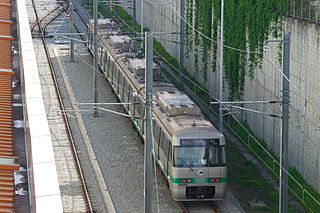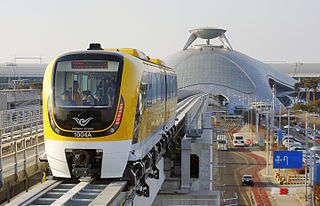Related Research Articles

A linear motor is an electric motor that has had its stator and rotor "unrolled", thus, instead of producing a torque (rotation), it produces a linear force along its length. However, linear motors are not necessarily straight. Characteristically, a linear motor's active section has ends, whereas more conventional motors are arranged as a continuous loop.

The West Midlands Metro is a light-rail/tram system in the county of West Midlands, England. The network has 33 stops with a total of 14 miles (23 km) of track; it currently consists of a single route, Line 1, which operates between the cities of Birmingham and Wolverhampton via the towns of Bilston, West Bromwich and Wednesbury, on a mixture of former railway lines and urban on-street running. The system is owned by the public body Transport for West Midlands, and operated by Midland Metro Limited, a company wholly owned by the West Midlands Combined Authority.

The Chuo Shinkansen is a Japanese maglev line under construction between Tokyo and Nagoya, with plans for extension to Osaka. Its initial section is between Shinagawa Station in Tokyo and Nagoya Station in Nagoya, with stations in Sagamihara, Kōfu, Iida and Nakatsugawa. Following the completion of the Tokyo-Nagoya line, the line will extend to connect stations in Mie, Nara and Osaka. The line is expected to connect Tokyo and Nagoya in 40 minutes, and eventually Tokyo and Osaka in 67 minutes, running at a maximum speed of 505 km/h (314 mph). About 90% of the 286-kilometer (178 mi) line to Nagoya will be tunnels.

The Amsterdam Metro is a rapid transit system serving Amsterdam, Netherlands, and extending to the surrounding municipalities of Diemen and Ouder-Amstel. Until 2019 it also served the municipality of Amstelveen but this route was closed and converted into a tram line. The network is owned by the City of Amsterdam and operated by municipal public transport company Gemeente Vervoerbedrijf (GVB) which also operates trams, free ferries and local buses.

Maglev is a system of train transportation that is levitated along a guideway through the use of magnetic forces. By levitating, maglev trains remove the rail-to-wheel contact present in conventional railways, eliminating rolling resistance.

The Leeds Supertram was a proposed light rail/tram system in Leeds and West Yorkshire in England. It would have been a three-line, 17-mile (27 km) system with 50 stations. It received provisional government approval in 2001, and was specifically for corridors ill-served by the existing heavy rail network. Supertram would have been 75% funded from the public sector, with final contracts for construction and a 27-year operating concession due to have been awarded in 2003. By 2004, disquiet about rising costs had caused the scheme to be scaled back, and it was finally cancelled in 2005 by the Transport Secretary, Alistair Darling.

Daejeon Subway Line 1 is a subway line is located in Daejeon, South Korea. After excluding the Seoul metropolitan area, it was the fourth subway line created in South Korea, following Busan, Daegu, and Gwangju. Its line color is ● green. It is 22.6 km (14.0 mi) long with 22 stations. It is the first of five planned lines for the Daejeon Metro.

The Turin Metro is the modern VAL rapid transit system serving Turin. It is operated by Gruppo Torinese Trasporti (GTT), a public company controlled by the municipality of Turin. The system comprises one 15.1-kilometre line with 23 stations connecting Fermi station in Collegno with Piazza Bengasi in Turin, near the border with the municipality of Moncalieri.

Daejeon Metro is the rapid transit system of Daejeon, South Korea, operated by the Daejeon Metropolitan Express Transit Corporation. The single-line subway network first opened in 2006 with 12 stations. The line was expanded in 2007 and it now consists of one line, 22 operating stations, and 22.74 kilometres (14.13 mi) of route.

Sejong or Sejong City, officially the Sejong Special Self-Governing City, is a special self-governing city and the de facto administrative capital of South Korea.

Vilnius Metro is a proposed rapid transit system in the Lithuanian capital Vilnius. Three lines are currently proposed to connect the busiest and most populous city districts. Its purpose is the relief of traffic congestion, which increased significantly in the 1990s and 2000s.
Siemens Mobility is a division of Siemens. With its global headquarters in Munich, Siemens Mobility has four core business units: Mobility Management, dedicated to rail technology and intelligent traffic systems, Railway Electrification, Rolling Stock, and Customer Services.

Indian Railways operates India's railway system and comes under the purview of the Ministry of Railways of Government of India. As of 2023, it maintains over 108,706 km (67,547 mi) of tracks and operates over 13,000 trains daily. According to the Ministry of Railways, a route capable of supporting trains operating at more than 160 km/h (99 mph) is considered as a higher speed or semi-high speed rail line.
Kolkata Monorail was a rail-based transit project planned for the city of Kolkata, West Bengal, India. This was the first proposed monorail in the country.

Urban rail transit in India plays an important role in intracity transportation in the major cities which are highly populated. It consists of rapid transit, suburban rail, monorail, and tram systems. According to a report published in 2021, a total of 2.63 billion people traveled annually in metro systems across India's sixteen major cities, placing the country as one of the busiest urban rapid transit hubs in the world in terms of commuters. The combined length of 895 kilometres of metro systems in India makes it the third longest in operation in the world.

Bristol Supertram was a proposed light rail system for the Bristol and South Gloucestershire regions of England. In 2001, the project was given backing from the government to build a line that would link the city centre with the North Bristol region, but the project was cancelled in 2004.

The Incheon Airport Maglev was a maglev line in South Korea that opened on 3 February 2016 and closed on 1 September 2023. It was the world's second commercially operating unmanned urban maglev line after Japan's Linimo. The trains were lighter, cutting construction costs in half. The majority of construction was completed by November 2012.
Coimbatore Metro, also known as Kovai Metro, is a proposed rapid transit system for Coimbatore, Tamil Nadu.
The city of Bristol in the United Kingdom has included a light rail transport system in its plans from the 1980s onwards. There has been no light rail in the city since the closure of Bristol Tramways in 1941.
References
- ↑ 이계주 (26 January 1995). "[지방면톱] 대전 지하철 5개노선 101km 확정". Hankyung (in Korean). Retrieved 7 September 2020.
- ↑ 윤경찬 (14 April 2014). "대전도시철도 2호선 자기부상열차 주목". MC News (in Korean). Retrieved 7 September 2020.
- ↑ "[2012년 10대뉴스/1위] 대전도시철도 2호선 건설사업 예비타당성 통과". City of Daejeon (in Korean). 18 December 2012. Retrieved 7 September 2020.
- ↑ "대전도시철도 2호선". Korea Development Institute (in Korean). 31 October 2012. Retrieved 7 September 2020.
- ↑ "대전도시철도 2호선, 노면 트램으로 최종 결정". Daejeon City (in Korean). 4 December 2014. Retrieved 7 September 2020.
- ↑ "도시의 틀 바꿀 트램! 시범노선 2020년까지 완공한다". Daejeon City (in Korean). Retrieved 7 September 2020.
- ↑ 양영석 (27 April 2018). "대전도시철도 2호선 차질 빚나…예비타당성조사 유효기간 만료" (in Korean). Retrieved 7 September 2020.
- ↑ 봉승권 (4 January 2018). "대전지하철 2호선 트램 신규 예타 대신 타당성재조사 받는다". C News (in Korean). Retrieved 7 September 2020.
- ↑ 이율 (29 January 2019). "정부, 국가균형발전 위해 24조원대 23개 사업 예타면제(종합)". YNA News (in Korean). Retrieved 7 September 2020.
- ↑ 조원대 (26 August 2019). "대전도시철도2호선, KDI 적정성 검토 통과". Korea emporary Equipment Association (in Korean). Retrieved 7 September 2020.